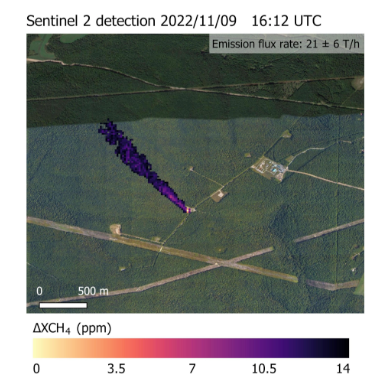What a catastrophic gas leak in Pennsylvania means for our climate and health

Update: According to the operator, this leak has been plugged.
By Adam Peltz and Jon Goldstein
A natural gas storage site in Western Pennsylvania has sprung a massive gas leak that’s impacting both the climate and the communities who live in Cambria County.
The leak began Thursday, Nov. 6 at a facility operated by Equitrans Midstream Corporation. Despite efforts from the company and state officials, it has continued for weeks – causing over 1 billion cubic feet of methane and other pollutants to fill the air. Its impact is massive – large enough to be seen and quantified from space from the growing network of methane satellites. The near-term warming generated from this single site over the course of a few weeks is roughly equivalent to emissions from 360,000 cars over a year.
It’s also an incredible waste of energy. The gas lost from this one leak could have met the annual natural gas usage needs of 15,000 homes and is worth $6.5 million.
The gas leak is one of the largest we’ve seen in the U.S. since the Aliso Canyon disaster in 2015. That months-long disaster spurred the Pipeline and Hazardous Materials Safety Administration to issue national standards for underground natural gas storage facilities. Those standards followed the guidelines of the American Petroleum Institute – and went into effect essentially unmodified with little transparency. And now, history has repeated itself. The fact that we keep seeing these problems erupt at this scale every few years demonstrates that we need to do a better job managing these massive climate and safety threats.
So what does that entail?
The rules PHMSA put forward have significant shortcomings. There were no standards for measuring risk or quantifying risk reduction. There were no specific requirements to evaluate and eliminate single points of failure. Well control planning details were scant. And there was little detail on emergency preparedness, safety, site security and other elements. In light of yet another gas storage disaster, it’s clear these problems need to be fixed through comprehensive regulations and not just industry guidelines (though improved guidelines incorporating EDF input are expected next year). And in addition to stronger rules, PHMSA – a small federal agency with important responsibilities – must step up enforcement and inspections to ensure industry is doing its job.
While an overhaul of underground natural gas storage rules and oversight related to well integrity is necessary to prevent disasters of this sort, a new set of oil and gas standards from the U.S. Environmental Protection Agency will help reduce the oil and gas industry’s methane pollution problem more broadly. Recently proposed updates to the nation’s methane rules would require oil and gas companies to regularly check facilities for leaks or problems at upstream and midstream facilities, including in the storage segment like this one in Pennsylvania. A newly enacted methane fee in the Inflation Reduction Act will also provide a strong economic disincentive for operators to allow problems at their facilities.
Governor Wolf and Governor-elect Shapiro have both been supporters of stronger standards around oil and gas methane emissions, not only because of the impact these emissions have on the climate but also because what they mean for the state’s air quality. Methane is emitted along with a host of other pollutants that are linked to cancer, respiratory illness and smog-formation.
Unfortunately, just recently, the Pennsylvania House Environmental Resources & Energy Committee, chaired by Rep. Daryl Metcalfe, voted to stall an effort to try and prevent this pollution.
The ongoing disaster in Cambria County underscores we need more pollution protections on the oil and gas industry, not less. Pennsylvania lawmakers and federal regulators need to up their game and adopt standards that can protect the climate, stop waste and save lives.











